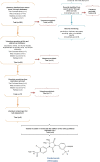A profile of enzalutamide for the treatment of advanced castration resistant prostate cancer
- PMID: 26109877
- PMCID: PMC4472073
- DOI: 10.2147/CMAR.S50585
A profile of enzalutamide for the treatment of advanced castration resistant prostate cancer
Abstract
Recent advances in understanding the mechanisms underlying the development and progression of castration resistant prostate cancer from androgen-sensitive prostate cancer have provided new avenues exploring efficacious therapies in a disease which is the second leading cause of cancer deaths among men in the western world. In the evolution of second generation anti-androgens, enzalutamide, a novel androgen-receptor signaling inhibitor, has emerged targeting multiple steps within the androgenic stimulation pathway. This review discusses what is currently known of the mechanisms surrounding castration resistant prostate cancer development and the current human clinical trials to determine whether enzalutamide presents a new hope for men with advanced prostate cancer. The issues of therapy resistance, withdrawal effects and cross-resistance are briefly touched upon.
Keywords: MDV3100; androgen receptor; anti-androgen; enzalutamide; metastatic castrate resistant prostate cancer.
Figures



References
-
- globocan.iarc.fr [homepage on the Internet] Prostate Cancer: Estimated incidence, mortality and prevalence worldwide in 2012. GLOBOCAN; 2012. [Accessed May 8, 2014]. Available from: http://globocan.iarc.fr/Pages/fact_sheets_cancer.aspx.
-
- Huggins C, Hodges CV. Studies on prostatic cancer. I. The effect of castration, of estrogen and androgen injection on serum phosphatases in metastatic carcinoma of the prostate. CA Cancer J Clin. 1972;22(4):232–240. - PubMed
-
- Feldman BJ, Feldman D. The development of androgen-independent prostate cancer. Nat Rev Cancer. 2001;1(1):34–45. - PubMed
-
- Lu NZ, Wardell SE, Burnstein KL, et al. International Union of Pharmacology. LXV. The pharmacology and classification of the nuclear receptor superfamily: glucocorticoid, mineralocorticoid, progesterone, and androgen receptors. Pharmacol Rev. 2006;58(4):782–797. - PubMed
Publication types
Grants and funding
LinkOut - more resources
Full Text Sources
Other Literature Sources

